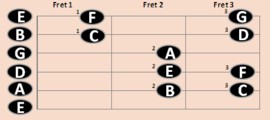Beginner classical guitar lesson 6 : Notes on the A string
All these free beginner classical guitar lessons have the same format. Have a look at how this page is layed out and become familiar with where things are. The heading tells you what the aim of the lesson is and the coloured box contains tips and guidelines. Below the coloured box are your guitar pieces that support the aim of the lesson and supporting resources which include accompaniment in mp3 format and free sheet music in pdf format.These lessons, designed for the beginner classical guitar player, build step by step with each lesson building on the previous lesson in the following ways: (i) knowledge of guitar technique; (ii) familiarity with music reading and (iii) strengthening - and in a safe way - your hands. Try and play through all the exercises provided at the bottom of the page. Remember that the house with the solid foundation is stronger in the long run.
I’m getting a lot of messages from people coming here because they want to learn to play guitar as part of worship. If this is you, you might want to join Aaron Anastasi’s programme. Aaron is a musician and a worship leader. He put together a step by step programme for aspiring Christian musicians. If you're interested, you can use the exercises and advice in learn-classical-guitar-today to develop your finger strength and dexterity and Aaron's lessons to work on strumming and worship music.
CLICK HERE TO LEARN WORSHIP GUITAR !!
Beginner Classical Guitar Lesson 6 - Aims
- Become familiar with and practice using the notes located on the A string (5th string).
- Become more comfortable with music in two voices (review lesson 4 on this topic).
- Using the p finger and i finger of the right hand to play two notes at the same time. Review lesson 5 for more information.
- Playing two notes simultaneously. Review lesson 5 for more information.
- Using the eighth note (or quaver.
- Working with a new timing 2/4.
Exercise 18
Exercise 1 to 17 are included in previous lessons . If you haven't already done these, I suggest that you go through them as these lessons build incrementally on each other in terms of finger strength and agility, music theory and interpretation.

I’m getting a lot of messages from people coming here because they want to learn to play guitar as part of worship. If this is you, you might want to join Aaron Anastasi’s programme. Aaron is a musician and a worship leader and put together a step by step programme for aspiring Christian musicians. If you are interested, you can use the exercises and advice in learn-classical-guitar-today to develop your finger strength and dexterity and Aaron's lessons to work on strumming and worship music. GO HERE TO LEARN WORSHIP GUITAR
Notes and guidelines
This piece has two voices. Review Lesson 4 for guidelines on how to approach music written in two voices.
Use the i- finger, m- finger and p- finger as indicated in the score. Notice that the fingering is provided for only the first two bars. The fingering approach provided in these bars are to be used for the rest of the piece of music. See finger names for an overview of the names of the fingers in classical guitar.
Note that the 'a' finger is introduced into your playing in Bar 7 of this piece. This is the second time that you are using this finger and it is bound to feel somewhat uncomfortable, but continue using it and it will soon feel comfortable.
The metronome speed is 110 for this piece.If this piece feels difficult, play through Exercise 16 and Exercise 17 first as they are slightly easier and will build you up to this piece.
Play along accompaniment for beginner classical guitar lesson 6
Click here for details on guitar supports including the Efel, the Dynarette and the Ergoplay.
Two mp3s are provided for this lesson. The one contains both parts of the music and the other contains the accompaniment. Listen to both parts of the music played together so that you can get a feel of the song. Then practice by setting your metronome at a very slow pace. Slowly push up the speed until you can play it confidently at a metronome speed of 80 bmp. When you can play it confidently at this speed, you can play along to the accompaniment provided.
Listen to the song by playing this midi
| |||||||||
Great! Let's keep moving forward.
Okay, now you know the drill. The exercise provided below aim at developing the i-m-i-m and p-i movement of your right hand and your familiarity with the G string. Listen to the mp3 provided to get a feel of the song. The sheet music can be downloaded by clicking on the PdF. d excessive movement. Simple become aware of when it happens and try and decrease the movement of the pinky when the finger is not in use.
|
|
Listen to the song
by playing this midi |
Well done!
Click here for the top three guitars that I recommend for beginners price range of $100 - $200 and intermediate level guitars which is a definite step up.
- You've finished your first 19 exercises, are now familiar with and practiced in using the notes of the 1st, 2nd, 3rd, 4th and 5th strings.
- You've practiced alternating between i-m-i-m and m-i-m-i with the right hand. You have added using p-i combinations and i-m-p and p-i-m with the right hand and, in this most recent lesson, you began using the p- and i- fingers together to play two notes simultaneously.
- You're now comfortable with the whole note, half note, quarter note and the dotted half note. In this lesson you practiced playing two parts - one part that used half notes and one part that used eighth notes (or quavers).
- A new aspect of your musicality was the introduction of music in multiple voices in Lesson 4 and 5. You've had another opportunity in Lesson 6, through Exercises 18 and 19, to play music with two parts - remember to separate the voices and play them separately before attempting them together. Also, be careful to play the note values as they are to be played.
Let's move on to Lesson Seven where you'll complete your knowledge of all six strings by getting to know the notes on the 6th string. Also, you are now ready to play your first solo piece.
And, equally importantly, just one more lessons and you'll be ready to prepare for the Grade 1 classical guitar examinations set by Trinity or the Royal School of Music(ABRSM) . Not bad for someone who started as a raw beginner is it?
Well done on the progress thus far.
Keep going through each of the lessons systematically. They've been designed to build up your technical capacity, your knowledge of the guitar and your understanding of the musicality that you will need. Remember, a solid house needs a good foundation.
That's great progress and in a very short period of time!
Let's move on to Lesson Seven where you'll be using notes on all six of the guitar strings.
Keep going through each of the lessons systematically. They've been designed to build up your technical capacity, your knowledge of the guitar and your understanding of the musicality that you will need. Remember, a solid house needs a good foundation.

You'll need to go a little deeper into music theory as you proceed. The best online resource for this is Guitar Theory Revolution. It recognises that music theory is very hard for guitarists because music theory has till now been located in the piano paradigm. The Guitar Theory Revolution overthrows the piano paradigm that is holding you back and embraces the attributes of the guitar to unpack music theory. In fact, it goes further and allows you to see that the guitar is one of the best instruments for learning theory.






